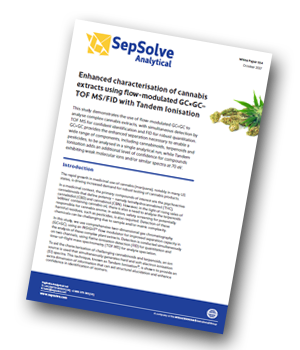This study demonstrates the use of flow-modulated GC×GC to analyse complex cannabis extracts, with simultaneous detection by TOF MS for confident identification and FID for robust quantitation.
 Introduction
Introduction
The rapid growth in medicinal use of cannabis (marijuana), notably in many US states, is driving increased demand for robust testing of cannabis products. In a medicinal context, the primary compounds of interest are the psychoactive cannabinoids that define potency – namely tetrahydrocannabinol (THC), cannabidiol (CBD) and cannabinol (CBN). However, in the light of rising sales of ‘edibles’ containing cannabis oil, there is also a need to analyse the terpenoids responsible for cannabis aroma; in addition, safety screening for potentially harmful residues, such as pesticides, is also required. Detection of these chemicals can be challenging due to sample and/or matrix complexity.
In this study, we use comprehensive two-dimensional gas chromatography (GC×GC), using an INSIGHT™ flow modulator for improved separation capacity in the analysis of these complex plant extracts. Detection is conducted simultaneously on two channels, using flame ionisation detection (FID) for quantitation and time-of-flight mass spectrometry (TOF MS) for analyte speciation.
To aid the characterisation of challenging cannabinoids and terpenoids, an ion source is used that simultaneously generates hard and soft electron ionisation (EI) spectra. This technique, known as Tandem Ionisation®, is shown to provide an extra dimension of information that can aid structural elucidation and enhance confidence in identification of isomers.
Experimental
Sample preparation: Six cannabis extracts (A–F, from plants of different origin) were prepared by QuEChERS extraction. For further conditions please refer to the White Paper.
Conclusions
This study has shown that GC×GC–TOF MS/FID using the INSIGHT™ flow modulator provides the sensitivity, spectral quality and chromatographic resolving power necessary for confident analysis of complex cannabis extracts. Parallel detection enables both confident identification by TOF MS and robust quantitation by FID in a single run, while powerful data-mining tools simplify the search for target compounds. In addition, Tandem Ionisation® adds an additional level of confidence in situations where 70 eV data alone cannot speciate similar compounds, without impacting laboratory workflow.




